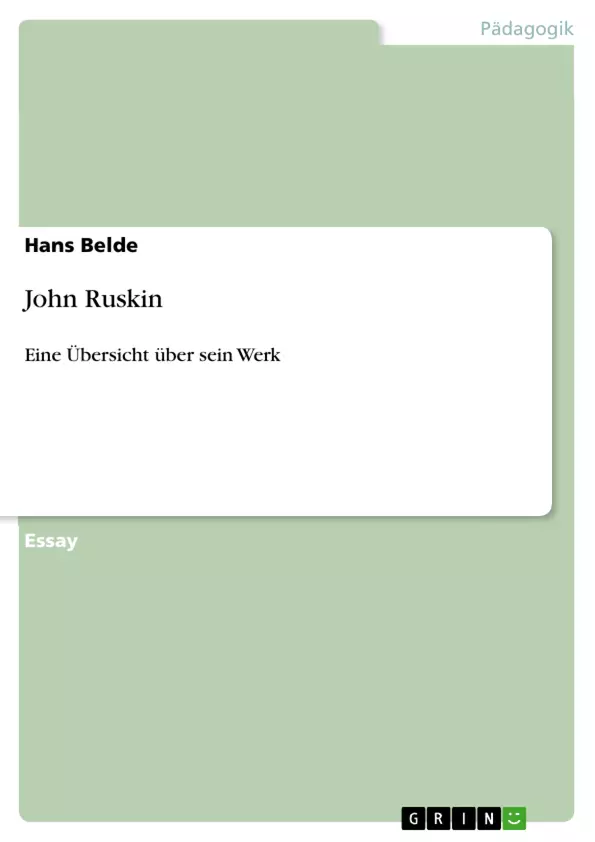John Ruskin (1819 – 1900) war nicht nur einer der originellsten Denker, sondern hat auch ständig an der Umsetzung seiner Ideen in die Praxis gearbeitet. Er hat nicht nur als Kunsthistoriker Schönheit gefeiert, sondern auch als Sozialreformer für ihre Erhaltung gekämpft. Hier wird eine Übersicht über sein umfangreiches Werk mit der Darstellung seines Lebens verbunden.
Inhaltsverzeichnis
- Erster Teil
- Erstes Kapitel: 1819 – 1854
- 1819-1838
- The Poetry of Architecture (The Architectural Magazine 1837/38)
- 1838–1843
- The King of the Golden River (1841)
- Modern Painters I: Part I Of General Principles, Part II Of Truth (1843)
- 1843 1846
- Modern Painters II: Part III Of Ideas of Beauty (1846)
- 1847 1849
- The Seven Lamps of Architecture (1849)
- 1849 1851
- The Stones of Venice I: The Foundations (1851)
- Notes on the Construction of Sheepfolds (1851)
- Pre-Raphaelitism (1851)
- 1851 1853
- The Stones of Venice II: The Sea-Stories (1853)
- The Stones of Venice III: The Fall (1853)
- 1853
- Lectures on Architecture and Painting (1854)
- 1853-1854
- Zweites Kapitel: 1854 - 1864
- 1854 1856
- Modern Painters III: Part IV Of Many Things (1856)
- Modern Painters IV: Part V Of Mountain Beauty (1856)
- 1856-1857
- Turner: The Habours of England (1856)
- The Elements of Drawing (1857)
- The Political Economy of Art (1857 [A Joy for Ever 1880])
- 1857 1859
- Inaugural Address at the Cambridge School of Art (1858)
- The Two Paths (1859)
- 1859
- Modern Painters V: Part VI - IX (1860)
- Unto this Last (Cornhill Magazine 1860)
- 1860 1863
- Essays on Political Economy (Fraser's Magazine 1862/63 [Munera Pulveris 1872])
- 1863 1864
- Drittes Kapitel: 1864 - 1869
- 1864 1868
- Sesam and Lilies (1865)
- The Study of Architecture in Schools (1865)
- The Cestus of Aglaia (Art Journal 1865)
- The Ethics of the Dust (1866)
- The Crown of Wild Olive (1866)
- Time and Tide. Twenty-fife Letters to a Working Man (1867)
- Modern Art (1867)
- 1868 1869
- The Mystery of Life and its Arts (1868)
- The flamboyant Architecture of the Valley of the Somme (1869)
- The Queen of the Air (1869)
- The Future of England (1869)
- 1870-1871
- Zweiter Teil
- Viertes Kapitel: 1870 – 1878
- A Talk respecting Verona and its Rivers (1870)
- Lectures on Art (1870)
- The Elementary Principles of Sculpture (1870 [Arata Pentelici 1872])
- The Story of Arachne (1870)
- Lectures on Landscape (1871)
- The Relation between Michelangelo and Tintoret (1871)
- Fors Clavigera. Letters to the Workmen 1 – 12 (1871)
- Munera Pulveris (Vorwort 1872)
- 1872-1873
- The Relation of Natural Sience to Art (1872 [The Eagle's Nest 1872])
- Fors Clavigera 13 - 24 (1872)
- Fors Clavigera 25 - 36 (1873)
- Sandro Botticelli and the Florentine Schools of Engraving (1872 Ariadne Florentina 1876])
- Three Lectures on English and Greek Birds (Love's Meinie 1873)
- Val d'Arno (1873)
- 1874 1875
- Fors Clavigera 37 – 48 (1874)
- The Aesthetic and Mathematic Schools of Art in Florence (1874)
- Mornings in Florence (1875 - 1877)
- 1875–1876
- Fors Clavigera 49 – 60 (1875)
- Fors Clavigera 61 – 72 (1876)
- The Economist of Xenophon (Vorwort 1876)
- Rock Honeycomb (1877)
- 1877-1878
- The Laws of Fésole (1877 – 1879)
- Guide to the Academy in Venice (1877)
- St. Mark's Rest (1877 – 1879)
- Fors Clavigera 73 - 87 (1877-1878)
- Proserpina. Studies of Wayside Flowers (1875 - 1879)
- Deucalion. Collected Studies of the Lapse of Waves and Life of Stones (1875 - 1878)
- Fünftes Kapitel: 1878 – 1900
- 1878 1881
- Notes on Prout and Hunt (1879)
- Fors Clavigera 88 - 89 (1880)
- Fiction, Fair and Foul (1880, 1881)
- The Bible of Amiens (1880-1884)
- 1881 1883
- Love's Meinie (Part III, 1881)
- Deucalion. Volume II (Kap. II und III, 1883)
- Modern Painters II (Re-arranged Edition 1883)
- Proserpina. Volume II (1882 – 1886)
- The Art of England (1883)
- 1883-1885
- The Art of England (5. und 6. Vorlesung 1883)
- The Storm-Cloud of the Nineteenth Century (1884)
- The Art of England (Appendix 1884)
- Fors Clavigera 90 – 96 (1883 – 1884)
- A Knight's Faith (1885)
- The Pleasures of England (1884)
- 1885-1887
- Praeterita (1885-1887)
- 1887–1889
- Praeterita III (1889)
- 1889-1900
Zielsetzung und Themenschwerpunkte
Dieses Buch widmet sich dem Leben und Werk des englischen Kunsthistorikers und Sozialphilosophen John Ruskin. Es verfolgt das Ziel, den Leser in die Gedankenwelt Ruskins einzuführen und seine Entwicklung als Künstler und Denker nachzuzeichnen. Das Buch beleuchtet Ruskins komplexe Persönlichkeit und seine vielfältigen Interessen, die von Architektur und Malerei über politische Ökonomie bis hin zu Sozialkritik reichten.
- Die Entwicklung von Ruskins ästhetischen und künstlerischen Ansichten
- Ruskins Kritik an der industriellen Revolution und ihren Folgen
- Die Bedeutung von Schönheit und Natur in Ruskins Philosophie
- Ruskins soziale und politische Engagement
- Der Einfluss von Ruskins Werk auf spätere Generationen
Zusammenfassung der Kapitel
Das Buch ist in fünf Kapitel gegliedert, die jeweils einen bestimmten Zeitraum im Leben und Werk Ruskins abdecken. Jedes Kapitel beleuchtet die wichtigsten Werke, Ereignisse und Einflüsse, die Ruskins Entwicklung in dieser Phase prägten.
Schlüsselwörter
John Ruskin, Kunsthistorie, Sozialphilosophie, Architektur, Malerei, Natur, Schönheit, Industrialisierung, Sozialkritik, Politische Ökonomie, Victorianismus.
- Quote paper
- Hans Belde (Author), 2018, John Ruskin, Munich, GRIN Verlag, https://www.grin.com/document/456281



